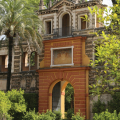Palaces, patios, Mudejar halls and sumptuous gardens, an inescapable jewel that we will discover with happiness, from morning to night.
The royal residence, with its palaces, patios, Mudejar rooms and gardens, is simply a marvel. Declared a World Heritage Site by Unesco, it is - along with the cathedral - the monument of Seville not to be missed. Arriving from the Plaza del Triunfo, you cross the formidable enclosure by the Puerta del León (Lion's Gate). The lion, immortalized in tiles, symbolized the victory of the Reconquest (for a short time, this gate was actually defended by a real lion). We enter the Alcázar Real (Royal Palace) where, traditionally since the Reconquest, the kings of Spain descend when they visit Seville. The site was already known to the Romans. In 712, the Moors built a fortress there. After the Reconquest, the Catholic Monarchs moved in. The current complex was built gradually, with each king adding his own touch.
The Sala de Almirantes (the Admirals' Hall) was, from 1503, the scene of the great decisions of exploration of the New World, including the voyage of Magellan.
The Palace of Peter the Cruel , one of the most important buildings in the Alcázar, was restored by Charles V and Philip IV. Outside, we will discover the beautiful patio de las Doncellas (Court of the Maids of Honor), a harmonious rectangle framed by a double row of marble columns, created by the best craftsmen of Granada. The maids, princesses of the blood, stood on the floor to follow the ceremonies that took place in the court. Also not to be missed is the Salón de Embajadores with its 15th century carved and gilded cedar wood dome. Although the work was first carried out by Moorish craftsmen who contributed all the Mudejar fantasy, especially in the sumptuous azulejos decorations, the subsequent works borrowed more from Europe and Flanders (the Salón de los Tapices with its tapestries in the salons of Carlos V, from the 16th century, very well decorated, is worth seeing).
Various patios also form key stages of the visit. The Patio de las Doncellas, the ladies, whose decoration was done by the greatest artists of Granada; the Patio de los Muñecas, the dolls, which owes its name to the faces that decorate one of its arches and was the place reserved for the servants who worked in the palace; the Patio de la Montería, the hunting patio, which was once a meeting place for the royal court before it became a gathering place for the hunts. Or the Yeso Garden, a garden with beautiful flowerbeds and streams that has preserved characteristic elements of the 12th century Almohad dynasty's Alcázar.
The gardens of the Alcázar are magnificent, of Arab influence, they were later reformed in Renaissance and Romantic style. Fountains, fountains, ponds, sculptures, bushes, shrubs and terraces planted with cypress and laurel alternate in a dazzling display of every moment. The Andalusians and then the landscape artists from North Africa have taken art to unprecedented heights, in order to satisfy the taste and senses of the caliphs. An ideal place for naps on hot summer days. Moreover, a cafeteria will allow you to take breaks in an idyllic place.
Cultural activities in which you can participate: conferences, theater or concerts as Nights in the Gardens of the Alcazar in summer.
Did you know? This review was written by our professional authors.
Book the Best Activities with Get Your Guide
Members' reviews on ROYAL ALCÁZARES (REALES ALCÁZARES)
The ratings and reviews below reflect the subjective opinions of members and not the opinion of The Little Witty.
Find unique Stay Offers with our Partners









Do Not Follow set Google maps directly to the place, it will take you around the palace but not to the proper entrance.
Set it to Puerta del León which is the entrance.